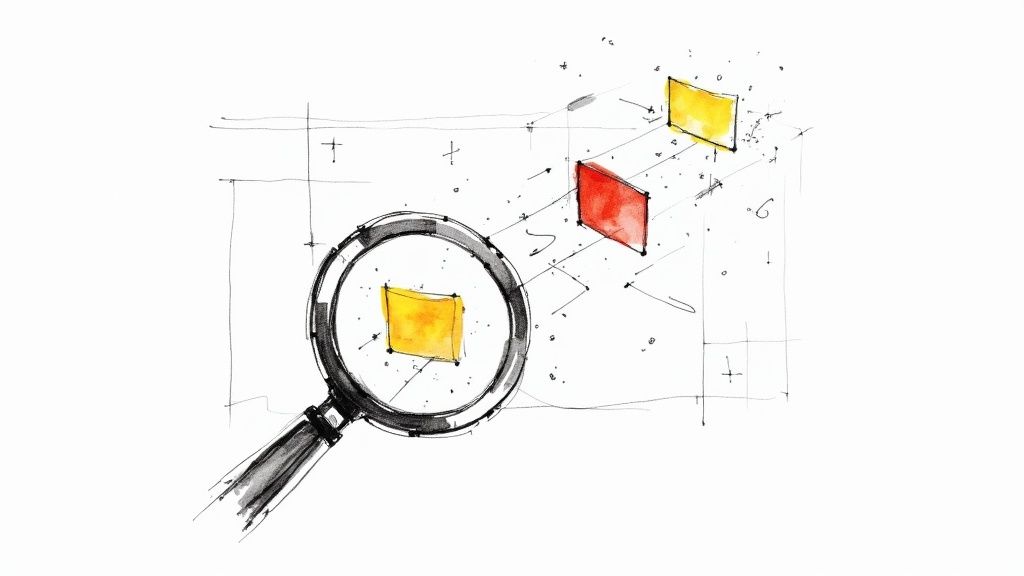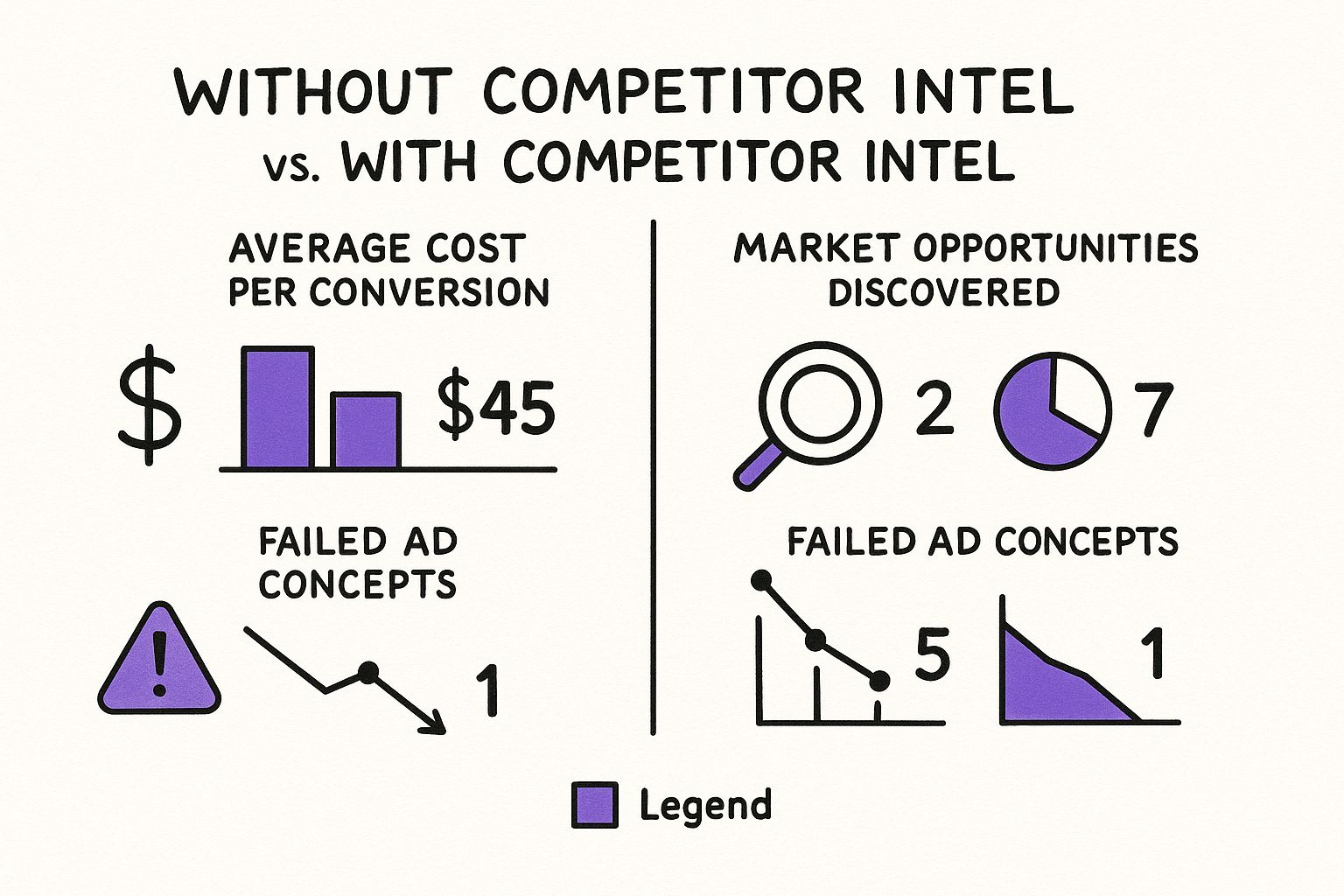How to Spy on Your Competitors’ Ads (and Not Get Caught)
Stop guessing and start winning. Use advertising competitive intelligence to see your competitors' ads, budgets, and winning strategies instantly.

Let's ditch the boring jargon for a minute. Advertising competitive intelligence is basically your legal, ethical spy kit for the ad world. Think of it as getting a peek at your competitor’s playbook before the big game—seeing what plays they're running, where they're running them, and who they're trying to score with.
What Is Advertising Competitive Intelligence, Really?

Here's the deal. If you were opening a coffee shop, you’d walk down the street to check out the other cafes, right? You'd scope out their menus, see their prices, and find out their daily special. Advertising competitive intelligence is just the digital version of that—for your ads.
It’s about gathering and analyzing data on what your competitors are up to with their advertising. This isn’t just about being nosy. It’s about making smarter, data-backed decisions instead of just flinging money at the wall and hoping something sticks. While we're focused on ads, this is part of a bigger field. To get the full picture, you can learn more about what is competitive intelligence in general.
So What Are You Actually Looking For?
When you dig into a competitor's ads, you're not just looking at one picture. You're hunting for patterns that reveal their whole game plan. You want answers to a few key questions:
- What's their message? Look at their ad copy. What problems are they solving? Are they trying to be funny, scary, or inspirational?
- Where are they spending their money? Are they blowing their budget on Meta? Or are they all-in on Google Search or TikTok? This tells you where they think their audience hangs out.
- What are their offers? You'll see if they're pushing free trials, big discounts, or webinar sign-ups. This is a huge clue into how they reel in new customers.
- Who are they talking to? The images, language, and vibe of their ads give you a pretty clear picture of their ideal customer.
> By looking at what your rivals do, you can spot market gaps, learn from their expensive screw-ups, and fine-tune your own strategy without spending a dime on guesswork.
Why This Is No Longer Optional
In the not-so-distant past, this kind of deep-dive analysis was a slow, manual grind that would make your eyes bleed. Not anymore. The competitive intelligence market exploded to around $8.2 billion in 2023, and it's not slowing down.
What's driving this? AI-powered tools that can sift through mountains of data in minutes. In fact, there was a 76% year-over-year jump in AI usage among competitive intelligence teams.
Sure, heavy-hitters like Semrush and Ahrefs can show you a lot, but let's be honest, they can be super expensive. For a more focused and affordable approach, platforms like already.dev use AI to deliver powerful insights without the "sell your kidney" price tag. This means even small businesses can get a massive—and totally ethical—head start on the competition.
Why Peeking at Competitor Ads Is a Smart Move
Trying to run ads without knowing what your competition is up to is like driving blindfolded. Sure, you’re moving, but you’re probably heading straight for a ditch. Looking at their ads isn’t about being a copycat; it's about being strategic.
When you analyze their strategy, the fog clears. You start to spot golden opportunities they’ve completely missed. They’ve already spent thousands testing what works and what doesn't. Their ad budget just became your free market research department. You're welcome.
Dodge Bullets and Save Cash
The biggest win from advertising competitive intelligence is learning from your rivals' expensive mistakes. Every failed ad, awkward headline, or clunky call-to-action they test is a lesson you don't have to pay for. It’s the ultimate cheat sheet for what not to do.
You get a front-row seat to see which hooks fall flat and which offers just don’t land. This intel lets you sidestep those same pitfalls, saving you a ton of cash and frustration on campaigns that were doomed from the start.
This infographic nails the difference between flying blind and using competitor intel to guide your strategy.

As you can see, having this data isn’t just a slight edge. It can dramatically slash your costs and seriously boost your chances of winning.
Sharpen Your Own Message
Once you understand how your competitors talk to customers, you can figure out a better way to do it. Sizing up their messaging helps you pinpoint what makes them special and, more importantly, discover how to make your own pitch sharper.
This boils down to a few key actions:
- Identify their core promises: What's the main benefit they push in every single ad?
- Analyze their emotional triggers: Are they using urgency, humor, or exclusivity to get people to click?
- Find the "unsaid": What are they not talking about? This is often where your biggest opportunity is hiding.
> By seeing their playbook, you can write your own counter-plays. You can craft a message that addresses a weakness in their offer or highlights a benefit they’ve totally ignored, helping you cut through the noise.
How To Legally Spy On Your Competitors’ Ads

Alright, time to put on your detective hat. The good news is that gathering advertising intel doesn't require a trench coat or a fake mustache. Most of the juicy info is hiding in plain sight—you just need to know where to look.
The easiest way to get started is with the free, built-in ad libraries that the major platforms now offer. Think of these as giant, searchable databases of every ad currently running. They were created for "transparency," but for marketers, they're pure gold.
- Meta Ad Library: The OG of ad libraries. You can search any advertiser and see every ad they're running across Facebook, Instagram, and Messenger.
- TikTok Creative Center: A fantastic resource for seeing what’s trending and which ads are crushing it. You can filter by industry, objective, and country.
- LinkedIn Ad Library: Perfect for B2B. See exactly how your competitors are targeting professionals and what kind of content they're putting money behind.
These free tools give you an amazing starting point. But if you want to dig deeper, you’ll need to level up your toolkit.
Upgrading Your Spy Gear
While the free libraries show you the ads, they don't tell you the whole story. They won't reveal targeting specifics, ad spend, or real performance metrics. That's where specialized advertising competitive intelligence tools come in.
A quick look around reveals a whole ecosystem of tools designed for this.
Advertising Intelligence Tools at a Glance
Here’s a quick comparison of the different types of tools you can use, from free options to more advanced paid platforms.
| Tool Type | What It's Good For | Cost | Best For | | :--- | :--- | :--- | :--- | | Free Ad Libraries | Viewing active ad creatives and copy. | Free | Quick spot-checks and creative inspiration. | | PPC/SEO Platforms | Keyword analysis, estimated traffic, backlink data. | $$ - $$$ | In-depth PPC and organic strategy analysis. | | Specialized Ad Intel Tools | Deep ad analysis, spend estimates, performance data. | $ - $$ | Marketers who need a complete picture of ad strategies. |
You've probably heard of the big names like Semrush or Ahrefs. They are incredibly powerful, but let's be real—they can be expensive. Their monthly fees can be a tough pill to swallow.
For a more accessible but equally powerful option, a tool like already.dev can give you the deep insights you need without the enterprise-level price tag. It helps you connect the dots between a competitor's ads, their landing pages, and their overall market position. This way, you’re not just looking at individual ads; you’re deconstructing their entire strategy.
> Your mission, should you choose to accept it, is to move beyond just collecting screenshots. The goal is to understand the why behind their ads to build a better strategy for your own.
A Simple Four-Step Process
Getting started is easier than you think. The key is to avoid getting lost in the weeds. Just follow a simple process.
- Define Your Mission: What are you actually trying to learn? New ad angles? Better offers? Weaknesses in their messaging? Always start with a clear question.
- Identify Your Targets: Go beyond your two biggest competitors. A key part of this is to find competitor PPC keywords they are bidding on. This can reveal smaller, scrappier rivals who are often more creative.
- Gather the Intel: Use a mix of free ad libraries and a tool like already.dev to collect data. Grab screenshots of their ads, note the copy, and always click through to their landing pages.
- Analyze and Act: Now, look for patterns. Are they always using video? Do all their promotions lead to a free trial? Use these insights to brainstorm testable ideas for your next campaign.
This structured approach turns random snooping into a repeatable system for getting ahead.
Turning Their Data Into Your Winning Strategy
So, you’ve got a massive folder of competitor screenshots and data. Now what? Just letting that intel sit there is like buying all the ingredients for a gourmet meal and then ordering pizza. The real magic begins when you use that info to cook up your own winning ad strategy.
Let’s be clear: the goal here is never to just copy-paste what they’re doing. That’s a fast track to becoming a cheap knock-off. Instead, you're looking to reverse-engineer their success to build something that's uniquely yours—and way more effective. It's about figuring out why their ads work, not just what they look like.
A Simple Framework for Analysis
It's easy to get overwhelmed. To make sense of it all, break down any competitor's ad campaign into three parts. Think of it as the M-O-C framework.
-
Messaging: What are they really saying? Look past the clever copy to the core emotional trigger. Are they hitting a specific pain point, promising a dream scenario, or using humor to be more relatable?
-
Offer: What’s the deal? A free trial, a "50% off for 48 hours" discount, or a webinar sign-up? The offer tells you everything about their customer acquisition model.
-
Creative: How are they stopping the scroll? Pay attention to their visuals. Are they using raw, user-generated content? Slick, animated videos? Or just simple, bold graphics?
When you look at their ads through this lens, you stop seeing random one-offs and start seeing a repeatable formula. Maybe Competitor X always uses customer testimonials in their videos when promoting their priciest plan. Bam—that’s a serious insight.
Deconstructing Their Funnel
An ad is just the front door. To really get what they're doing, you have to walk through it. Click their ads. Study their landing pages. Is it a long-form sales page? A quick-and-dirty lead capture form?
> The journey a customer takes after clicking an ad tells you more than the ad itself. It reveals the entire machine built to turn a click into a customer.
Mapping their funnel helps you find weak spots. Maybe their ads are brilliant, but their landing page is a confusing mess. That's a golden opportunity for you to create a clearer experience and win over customers they should have kept.
This kind of analysis is getting a huge boost from AI. According to the IAB’s State of Data 2025 report, AI is on track to power nearly every part of media campaigns by 2025. While only 30% of companies have fully integrated AI across their campaigns today, the direction is obvious.
How AI Is Supercharging Ad Intelligence

Let's be honest. Manually sifting through thousands of competitor ads is a special kind of nightmare. It’s tedious, and by the time you've crunched the numbers, the data is already old news.
Thankfully, AI is here to save us from spreadsheet misery. This isn't some far-off concept; it's happening right now. Think of AI as the tireless analyst you always wanted but could never afford. It processes massive amounts of ad data in minutes, freeing you up to focus on strategy.
Imagine trying to find a needle in a haystack. The old way was to pick through every piece of straw by hand. AI is like having a giant magnet that pulls the needle right out for you.
AI Is Your New Secret Weapon
So, what can this AI magic actually do for your advertising competitive intelligence? Instead of just showing you a competitor's ads, it can tell you the story behind them.
- Thematic Analysis: AI can automatically group thousands of ads by theme. It can instantly tell you if your main rival is suddenly pushing a "sustainability" angle or focusing on a new "work from home" feature.
- Trend Spotting: It can pinpoint emerging trends in messaging and visuals. You’ll be the first to know if video ads with a certain aesthetic are starting to dominate your niche.
- Predictive Insights: Some advanced tools can even help predict a competitor's next move by analyzing past campaign launches and seasonal patterns.
> The real power of AI is that it moves you from just seeing what your competitors are doing to understanding why they're doing it.
This shift is why the AI marketing industry is projected to hit a whopping $107.5 billion by 2028. The growth is being driven by AI’s ability to offer real-time market intelligence that was once out of reach.
Making Powerful Intel Accessible
Hearing "AI" might make you think of expensive, complicated platforms. Big tools like Semrush and Ahrefs have powerful AI features, but as we've said, they come with intimidating price tags.
This is where a new wave of tools is changing the game. Platforms like already.dev are using AI to make powerful ad intelligence accessible to everyone, not just mega-corporations. This is a core part of the larger trend of AI-powered market research, which is putting incredible tools in the hands of startups and small businesses.
To get ahead, exploring the top 10 AI tools for competitor analysis can give you an incredible edge. With AI, you no longer need an army of analysts to get a clear view of the battlefield.
Common Mistakes That'll Sink Your Competitor Analysis
Getting your hands on advertising competitive intelligence feels like you've unlocked a cheat code. But even with the best intel, it's surprisingly easy to get it wrong. A few common missteps can turn powerful insights into a complete waste of time.
Let’s walk through the big pitfalls so you can sidestep them.
The absolute worst mistake? Becoming a copycat. It's so tempting to see a competitor's ad crushing it and think, "I'll just do that!" Please don't. You'll end up sacrificing your brand’s unique voice and looking like a cheap knock-off.
> Think of competitor research as a compass, not a GPS. It should help you find your own path, not give you turn-by-turn directions to someone else's destination. Let their strategy inspire you, but never just copy it.
Getting Trapped in "Analysis Paralysis"
Here’s another classic blunder: getting so buried in spreadsheets and data that you forget to actually do something. This is "analysis paralysis," and it's a real threat. You spend weeks collecting screenshots but never actually launch a campaign.
Remember, the goal of advertising competitive intelligence isn't to build a flawless report. It's about finding quick, actionable insights you can test now.
- Don't boil the ocean. Pick just three to five direct competitors and stick to them.
- Set a deadline. Give yourself a specific timeframe for research, then commit to launching something.
- Action beats perfection every time. A good campaign that's live today is infinitely better than a "perfect" one that never sees the light of day.
Overlooking the Underdogs
It’s natural to fixate on the big dogs in your space. They've got monster budgets and massive reach. But if you only watch the giants, you're missing a huge piece of the puzzle.
Often, it's the smaller, hungrier startups that are doing the most creative work. They can't afford to be bland, so they're the ones testing weird new angles and clever funnels.
These scrappy rivals are a goldmine of fresh ideas. While big-name tools like Ahrefs or Semrush are great for tracking major players (if you've got the cash), a platform like already.dev is designed to help you spot these hidden gems. It lets you discover those up-and-comers who are punching way above their weight, giving you a far richer picture of what’s actually working.
Frequently Asked Questions
What's the most important thing to look for?
It’s easy to get lost in the weeds, but the real key is looking for patterns, not just a single ad.
Think of it this way: one ad is just a blip on the radar. But a series of ads all hitting the same customer pain point with a similar offer? That’s a full-blown strategy.
Those patterns are what tell you what your competitor truly believes is working for them. That’s the gold you're digging for.